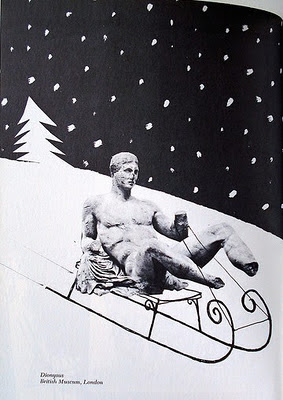The following video documents footage from a two-day celebration during the Greek Military Junta of 1967-1974. It plainly illustrates the dictators' need to present their "revolution" as a legitimate episode, the most recent one, in the Greek historical timeline, starting as far back as the Minoans and coming through the Classical and Byzantine era to the Greek War of Independence in 1821.
This is an interesting example of archaeological kitsch filled with a wealth of messages well worth presenting in detail some time - if such a study already exists I'd love to know about it.
******
I am immensely indebted to archaeologist Kostas Paschalidis for bringing this wonderful film-clip to my attention.
The celebration begins with an impressive Minoan procession with all kinds of interesting details directly derived from representations of the Minoan lifestyle: notice the giant horns of consecration, the "Princes of Lilies" in a row (one obviously wasn't enough) or the plastic pairs of snakes in the hands of the seated goddess and the curious vases carried by the male participants. The Classical era is represented through snapshots of both Greek and Persian soldiers from the Persian Wars and groups of dancers and musicians - no reference to the Greek mental achievements. The Byzantine era is presented through a procession with cavalry and footmen escorting Justinian and Theodora as they are depicted in the Ravenna mosaics (though the modern Justinian's beard is strikingly thicker).
The reference to the Greek War of Independence works -as the speaker explicitly states- as a connecting link between the ancient and byzantine past and "the revival of contemporary Greece". The procession ends with references to the Junta's symbols. Number "21" refers to the 21st of April 1967 the date of the military coup -and evidently works well with "1821", the date of the outbreak of the Greek War of Independence.
The final frame is the junta's iconic image of a phoenix resurrecting in flames against which the figure of a soldier in arms is placed.
The final frame is the junta's iconic image of a phoenix resurrecting in flames against which the figure of a soldier in arms is placed.
This is an interesting example of archaeological kitsch filled with a wealth of messages well worth presenting in detail some time - if such a study already exists I'd love to know about it.
If I may add a final note: I find the connection with the Greek timeline presented in the opening ceremony of the Athens Olympic Games in 2004 somehow disturbing.
And interestingly enough: the Mycenaeans are absent in both timelines.*
******
UPDATE*
Kostas Paschalidis in a facebook discussion correctly recalled that the Mycenaeans are present in the Athens Olympics timeline (known as "Clepsydra") with a float presenting a group of Dendra armours and a golden Agamemnon mask over them.
Here's a photo to document this instance.
******
UPDATE*
Kostas Paschalidis in a facebook discussion correctly recalled that the Mycenaeans are present in the Athens Olympics timeline (known as "Clepsydra") with a float presenting a group of Dendra armours and a golden Agamemnon mask over them.
Here's a photo to document this instance.
******
I am immensely indebted to archaeologist Kostas Paschalidis for bringing this wonderful film-clip to my attention.














